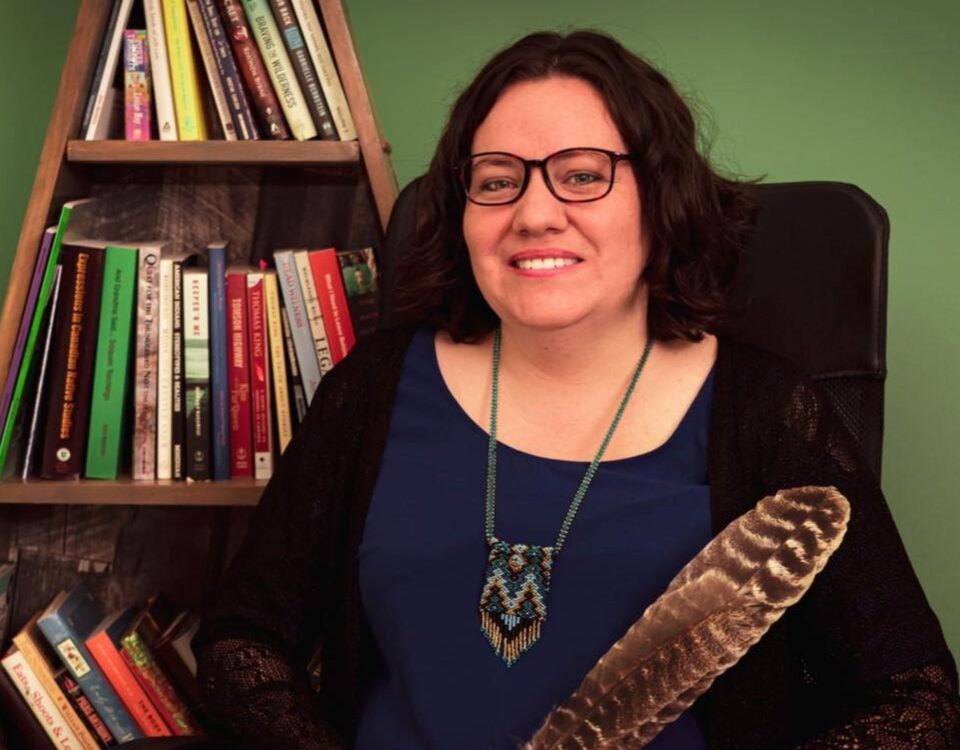Lindsay Brant
Literary, Tyendinaga Mohawk Territory

Kawennenhá:wi – She carries the words
By Jennifer Shea
Lindsay Brant is a proud Indigenous woman with a clear vision for her life. Not yet 40, she is a mother of two school-aged boys, an educational developer and adjunct lecturer at Queen’s University, a storyteller/writer, a motivational speaker, and a PhD candidate.
She describes her life priorities: “First, I stand in my identity as a Mohawk woman and that orientation to family and community and connection is what brings about my storytelling.”
Since she was 7 years old, Lindsay wanted to be a writer. She published her first story in the school yearbook and was excited to see the reaction of those reading her work.
“I struggled for years with self-confidence because of trauma in my life. I realized that I had to rely on something, and that something has been my spirituality, my connection to my culture, and my words. It was when I was in moments of crisis that I had whispers in my mind of ‘Be brave’ and ‘Use your words’. I realized my words are my strength.”
In fact, Brant’s Mohawk name “Kawennenhá:wi” means “She carries the words.”
“I had forgotten about that part of me. ‘She carries the words’ makes so much sense to me because I feel like I’m just a vessel sometimes. These words just find me. They almost drop into my mind and that’s how I create.”
Brant’s poetry has been captured in the published books This is Me Now and Sharing Anthologies – Volume 5. She has also written and published a children’s book Sammy the Sensitive Seal as a way of supporting her oldest son when he was 3: “I wanted him to know that he could navigate things (emotionally). My son immediately knew that he was Sammy in that book. Now, my (younger) son who’s 8 says, ‘I’m Sammy’ when we read the book together.”
In her early twenties, Brant wrote a book about self confidence. “I was extremely, painfully shy growing up and I wrote about what it takes to be an ‘unshackled soul’; what it means to free yourself from the shame and embarrassment of being who you are,” she says. “I had a lot of confidence issues to work through and the way I worked through it was to write myself into that space to fake it until I made it.”
Another children’s story by Brant, The Happy Home Fairy, is currently being printed and a collaboration with County-based visual artist Karole Marois is on exhibition at the Parrott Gallery in Belleville until March 30. The pair have worked together in the past, with Brant supplying poetry to accompany Marois’ artworks.
Brant’s storytelling and cultural connection play an important role in her employment and studies at Queen’s University. As an educational developer, she works with other faculty to incorporate concepts of decolonization and indigenization in their curricula and research programs. As a lecturer, she teaches a commerce course in the Queen’s Smith School of Business called Relationships and Reconciliation. Her research and writing for her PhD revolve around the same subject matter: “My portfolio for my PhD will include my poetry, my writing, and everything that I’ve done in terms of scholar Lindsay, artist Lindsay and writer Lindsay. I’m really proud that I can present something to the academy and to the world that is fully me.”
Brant’s vision for the future includes helping to lead the charge in pushing back against inaccurate and stereotypical narratives about our Indigenous people. “I see myself as a change-maker. I’ve been given that opportunity at Queen’s and it’s something that I don’t take lightly. I hold it as a deep responsibility to represent myself and my community well.”